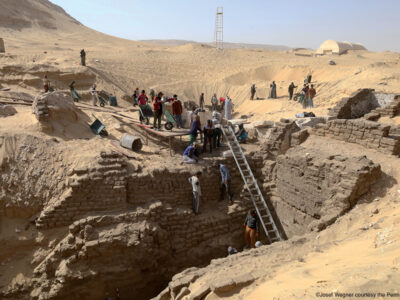
In which the author takes a break from the rigors of her own ethnographic research in France’s Dordogne region to visit with eminent Penn archaeologist Harold Dibble as he plumbs the mysteries of early human and Neandertal behavior—and plots his next gourmet meal.
By Beebe Bahrami
Sidebar | Neandertals, Ourselves
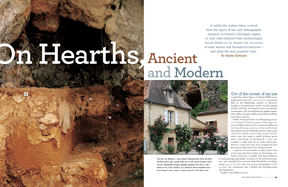
Out of the corner of my eye I spied the robust figure of Harold Dibble as he zipped across the Place de la Liberté. It was early May at the Wednesday market in Sarlat-la-Canéda in southwestern France. A man walked briskly with him, moving his arms in animated conversation. The two whisked past garden stands, olive sellers, foie gras tables, jarred black truffles, and walnut liquors.
Dibble—Penn professor of anthropology, curator-in-charge of the European archaeology section and deputy director for curatorial affairs at the Penn Museum, and one of the world’s leading experts on the Paleolithic period—had a grin on his face, which I knew either meant that the other man had made a really brilliant point about something archaeological or had just cracked a really bad (as in really good) pun. Before I could hail them, they disappeared into the narrow labyrinth of the medieval town.
I’d gotten to know Dibble in 1987, when I was a first-year doctoral student in the human evolution course he co-taught with then professor of anthropology Alan Mann. In honor of the inveterate punster, who sprinkled his lectures with Paleolithic wordplay, using knap, stone, flint, and chip in every imaginable double entendre, my classmates and I dubbed the teaching team The Mandibles.
I hadn’t seen Dibble in years.
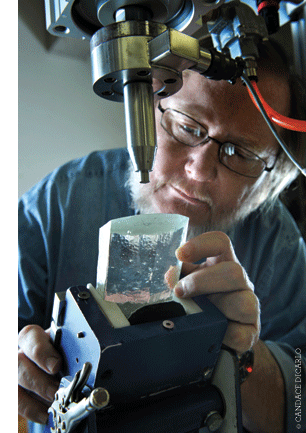
I rushed to my apartment and quickly emailed him, asking if he was indeed in Sarlat. Within a few hours I received his stunned response affirming that I had not witnessed someone else masquerading as he. When he inquired why I was there, I explained that I was doing contemporary ethnographic fieldwork in the Perigord, more popularly called the Dordogne, for much the same reason his favorite research subjects—Neandertals and early modern humans—had made the region home: delicious food, delightful climate, fascinating culture, and great beauty.
The Dordogne is a region that skipped industrialization, and so the mind can range freely as to what older lifeways were like, however far back you wish to go, anthropologically.
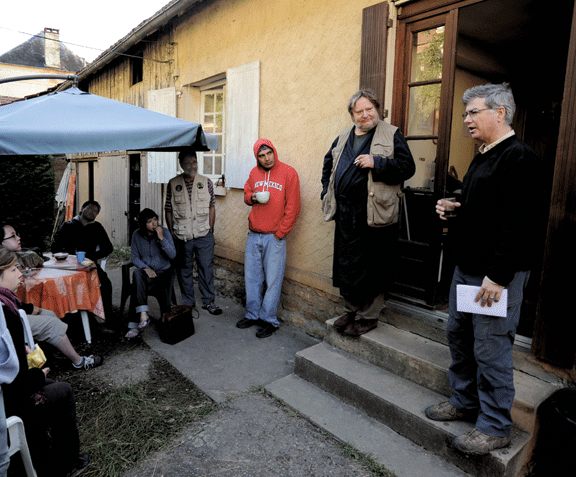
Dibble has dedicated his life to understanding Neandertal and early modern human behavior through systematic and innovative fieldwork and analytical techniques at several Paleolithic sites. He is joined in this effort by four other project directors: Dennis Sandgathe, a Paleolithic archaeologist from Simon Fraser University in Vancouver (and, as it turned out, Dibble’s companion in the marketplace); Shannon McPherron Gr’94, a Paleolithic archaeologist from the Max Planck Institute for Evolutionary Anthropology in Leipzig, Germany; Alain Turq, the chief curator at the Musée National de Préhistoire des Eyzies, France; and Paul Goldberg, a geoarchaeologist from Boston University. While Dibble and the team work all around the Mediterranean, from Egypt to Morocco to France, the Dordogne is home central.
Through their combined work the team has arrived at interpretations of new and old data that turn the tables on what we thought we knew about Neandertals and ourselves.
The next day we agreed to meet for lunch at the Hotel-Restaurant Delpeyrat in Carsac, a village that has been Dibble’s home base since 2000. Sandgathe joined us.
Each spring the two fly to France and open up the small house they rent in Carsac and then take off for their dig in Morocco throughout May, returning to Carsac in early June to commence the dig season in France.
The site in Morocco, La Grotte des Contrabandiers, or Smugglers’ Cave, is a Middle and Upper Paleolithic cave occupied by early modern humans from 120,000 to 10,000 years ago. Curiously, it is also on the white truffle route, making me suspect that Dibble and Sandgathe pick their sites just as did our hominid ancestors, to be near gourmet food sources. Be that as it may, archaeologically speaking, the site provides a valuable window on early humans before they came in contact with Neandertals.
“There is a lot of debate about early modern physiology and behavior,” explained Dibble, “so [Smugglers’ Cave] allows us to look at a site contemporary with Neandertals in Europe but [located] in Africa,” where Neandertals did not live. This means that the “behaviors found in Africa will be exemplary of modern human behavior.”
Similarly, in their work in Abydos, Egypt, from 2000-2007, the team was looking for indications of what early modern behavior was like prior to contact with Neandertals “because at some point,” continued Dibble, “around 150,000 to 160,000 years ago, [early moderns] spread out from Africa. The Nile valley was a natural corridor out. We were trying to find more direct evidence. It’s important to make connections … Neandertals are different [from us] and therefore very interesting.”
As soon as we sat down to lunch, the restaurant owners, Philippe and Aline Delpeyrat, and their son and daughter, Aurelie and Sabastien, came out to greet us and to joust with Dibble and Sandgathe. Philippe proudly stated that he had known Dibble for 32 years. He also confirmed that the two archaeologists pull a practical joke on Restaurant Delpeyrat each year.
Aurelie went to the back and returned with a menu the family saved from two years ago. Opening to the house specialties, she pointed at a selection Dibble and Sandgathe had secretly slipped into the regular menu.
“Here it is,” she said, “Beans à la Dibble.” Its English translation described it as, “White beans simmered in secret base.” The day of the menu heist, Dibble and Sandgathe stationed themselves at a table for two along the back wall and watched the lunchtime drama unfold as people inquired what Beans à la Dibble was, exactly. The family was in stitches when they realized their menu had been hijacked. Philippe and Aline decided to improvise, asking Dibble how to make the dish, as some patrons were seriously thinking of ordering it. When pressed, he said, “It’s really a cassoulet with white beans, tomato paste, onions, sausage, stuff, you know, a basic cassoulet.”
“This year,” Aurelie Delpeyrat leaned over and confided, “we know something is going to happen, but we have no idea what it might be.” Dibble and Sandgathe innocently looked on as if they had no idea what she meant.
By the time lunch was over, Dibble had invited me to visit their recently excavated sites, Pech de l’Azé and Roc de Marsal, when they conducted a day of formal visits in early June upon their return from Morocco. The day was for the Societé préhistorique française, the French Prehistory Society, a group of around 300 professional archaeologists and amateur archaeology buffs.
In early June, I ascended the rise on which stood Roc de Marsal, prime real estate in any epoch with its Tuscan-like-rolling-hills-view of the valley below. Roc de Marsal is a Middle Paleolithic site close to Les Eyzies, near the Vézère River, that dates to around 80,000 to 40,000 years ago. At its entrance stood Dibble, donning an Indiana Jones-style Fedora and chatting with Guillaume Guerin, a colleague from the University of Bordeaux, and Alain Turq. Inside the small cave stood Sandgathe, explaining in French to a couple of local archaeology aficionados that during the 2003-2009 dig seasons the team located 30 distinct fire hearths, indicating fire use during certain periods of its occupancy by Neandertals.
Curiously, though, the hearths only occurred in strata related to warm climatic periods. “There are no hearths in the strata during cold climatic periods, telling us that the Neandertals could use fire, such as that gathered from a lightning strike during a spring storm, but not make it,” Sandgathe elaborated. “[This] might explain why we see no fire hearths when the weather was particularly cold, a time you would imagine fire would be made if one could. But we don’t think they could.”
This picture carries over from their findings from the nearby Middle Paleolithic Neandertal site that they excavated a few years back, Pech de l’Azé IV. There they also found evidence for fire use, controlling it and using it in discrete spaces, along with the accompanying burnt bone and flint in the hearths, but, again, no evidence for fire in colder seasons. “The fire strata at Roc de Marsal was during warm periods,” Sandgathe said. “The same is true at Pech de l’Azé—warm periods had more lightning strikes. The correlation of the evidence for fire use at Neandertal sites and times when natural fire access was high (warm periods) is high.” Sandgathe paused and Dibble finished the thought. “We’re pretty much on our own in thinking it was from lightning strikes. That [Neandertals] were controlling fire, just not making it.”
This is a case of the popular imagination casting Neandertals in our image but not considering the entire range of evidence that supports or negates the image.
The two explained, in their easy give-and-take manner, that evidence for fire use was lacking in the strata corresponding to glacial periods, a time when the desire for a warming fire would be strong but when there would be much less lightning to produce it naturally. At the coldest periods during the European Middle Paleolithic, which occurred around 120,000 years ago and again around 60-70,000 years ago, prime periods of Neandertal occupation, the temperatures could drop to around 10 degrees Fahrenheit colder than today. If someone had the ability to make fire, this would be the optimal time to do so. But they didn’t.
Roc de Marsal is also famous for what has been deemed an intentional burial of a Neandertal infant. Back in the 1960s, amateur French archaeologist Jean Lafille excavated the site. He came across the fossilized remains of a Neandertal child who died at around two or three years old and was buried face down in what looked like a pit. It was an exciting find, and the infant and the sediment around which it had been found were carefully removed and taken to a lab in Paris for further analysis. The find was viewed by Lafille and by Francois Bordes, the prominent Paleolithic archaeologist who oversaw the discovery, as evidence for intentional burial among Neandertals. Roc de Marsal’s infant has since become one of the oft-cited cases for evidence of such behavior.
As with Neandertals and fire-making, however, the team’s findings cast doubts on this conclusion. When Dibble and his colleagues reopened the site, from 2003-2009, studying the prior excavation records, data, and finds and applying new techniques and further excavation to the cave, two critical perspectives arose.
First, they discovered that in the cave there were ancient subterranean water channels running through the rock, creating holes and grooves throughout. “We went back to the original descriptions to get to the root,” said Sandgathe, “looking at fieldnotes and very basic information. At the time, no one questioned that Neandertals buried their dead. But when you do look at the description, there’s something that contradicts this, like digging a hole. The skeleton hole was continuous with the sediment layer around it, therefore, it wasn’t a hole.”
The Neandertal infant had been found in one of the water channels and it did not appear that a hole had been dug for him or that he had been intentionally placed there. That he was face down, an unusual orientation by comparison with human burials across time and space, added to the sense that maybe this was an accidental burial; perhaps the infant fell into the channel and drowned or was placed in a natural grave and left there for natural forces to finish the work.
“Thinking that Neandertals buried their dead,” continued Sandgathe, “makes them more human, more like us, so we like this idea. But there’s not enough evidence to prove it. It’s a case of emotion overriding science, which however warm and fuzzy the feelings, must remain neutral and stick to the facts.”
Last year, actor and filmmaker Alan Alda came to Roc de Marsal expressly to interview Dibble, McPherron, and Sandgathe for his PBS special, The Human Spark. Alda inquired, “Do you have a feeling for what essential thing differentiates us [from Neandertals]?” McPherron, Sandgathe, and Dibble respectively answered: creativity, slightly more flexibility, and language and symbolism. Essentially, our ability to carry our innovations and ideas into the future, to pass them on through communication and broader consideration, made the difference. Somehow, anatomically modern humans managed to take their expanding ability to think symbolically and carry that on with each other, opening up many more possibilities. With Neandertals, Alda concluded from the responses he heard, “you might have had the beginnings of symbolism, but they wouldn’t spread.”
With early modern humans it was different. They engaged the potential for symbolism, to communicate ideas not only spatially to each other but also across different groups and across different generations, thus allowing for a creative idea to last long enough to be modified and perhaps even perfected to a strong adaptability.
Off camera, with their senses of humor, “Harold and Alan hit it off immediately,” Sandgathe confided. I asked for an example, having enjoyed bad puns for a whole semester in 1987. “We all went to the back part of the cave,” Dibble recalled, “and Alan sat down on a kind of shelf of sediment that was the leftover edge from where the block of sediment containing the Neandertal skeleton had been removed back in the 1960s. When he sat down he crossed his legs, so he had one foot sitting in the exact spot where the remains were found. I turned to him and said, ‘Alan, I know you don’t want to hear this at your age, but it looks to me like you’ve got one foot in the grave right now.’”
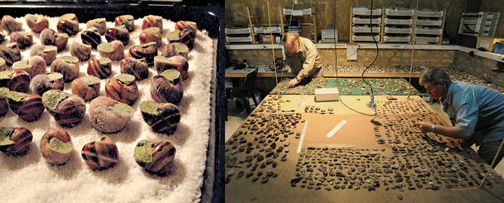
Three days after the site visit, I joined the dig team for dinner at their homebase. Dibble picked me up in Sarlat and on our way to Carsac we stopped at a small grocery store. “I’ll be just a minute,” Dibble said as he hopped out of the car. “I’m concerned that there is enough meat to eat for the group.” He then added over his shoulder, “A well-fed group is a happy group.”
When Dibble returned to the car, balancing packages of thick chicken breasts, I learned that he planned the entire season’s meals on an Excel spreadsheet, both lunch and dinner. He never repeated a meal, drawing from a huge, largely classical American and French, repertoire. It is small wonder that Dibble’s many publications include a cookbook.
Coauthored with chef Dan Williamson—who was the chef during several seasons in France—and illustrated by Brad Evans, The Human Evolution Cookbook (Penn Museum Publications, 2003) is a great introduction to human evolution paired with some of Dibble’s and Williamson’s most delicious—and deliciously named—recipes (such as Mousterian Goulash, Flint Fritters, and Pech de l’Azé Peche Melba). The reader gains a clear and accurate understanding of human evolution, from Australopithecines to the present, along with plenty of ways to satisfy a newly whetted appetite.
Arriving at the dig’s residence I discovered it was actually a converted séchoir à tabac, a high-roofed, wooden, side-ventilated tobacco-drying house from the early 20th century. It contained the lab as well as some sleeping space on the upper level.
Dibble got busy in the kitchen, situated in a small stone house attached to the séchoir, giving chopping and cleaning orders to his excavation crew-turned-sous-chefs as he seared chicken breasts for dinner. Sandgathe uncorked a bottle of Pecharment red and set it on the kitchen counter to breathe. He and I then went outside and sat in the verdant garden.
Bird song surrounded us and on the other side of the neighboring cornfield the sun’s last rays were bringing out the golden tones of the 12th-century Romanesque stone church in the heart of Carsac. Local accounts claim that Carsac’s church stands in an ancient druidic forest, at the heart of the sacred grove once venerated by Celts who likely lived here around 2,500 years ago.
To our right jutted a chalky cliff wall, a pan-regional landscape feature that attracted Neandertal and early modern human inhabitants much more ancient than the Celts. Today, more recent humans, from the 17th to the 20th centuries, have built stately stone homes of the same material right up against the cliff wall. One neighbor was weeding her cliff-side garden. A white goat followed her, hoping to nab a morsel from the unwitting biped.
At every turn, it was impossible to escape the feel of deep ancestry in a region that very likely has been occupied continuously by hominids for at least 400,000 years.
Dibble suddenly stuck his head out the kitchen door and asked, “Do you like snails?” I indicated I did. I’d already seen his supply of escargots à la Bordelaise on the counter. Sandgathe quickly told me, and Dibble if he’d listen, “I don’t. You can eat them. I won’t. I mean, I like butter and garlic. I find snails are just a vehicle for the butter and the garlic. They’re like erasers. I don’t need to eat an eraser. But garlic bread is good.” Dibble ignored him.
Dibble and Sandgathe’s easy joking relationship exists side-by-side with a seamless and efficient collaboration. The two communicate year-round, planning and organizing the dig season, and then are together day and night once the season commences, first in Morocco and then in France for the summer. They also have an uncanny manner of what appears to be telepathic communication, like that of a long-married couple. I witnessed it over dinner preparations when Dibble realized he needed to call a colleague to arrange something and Sandgathe casually said he’d already done it. Dibble relaxed and went back to preparing a Vermouth-laced, caramelized-onion and mushroom cream sauce and noodles that would accompany the chicken.
Dibble next turned to crew member Jonida Martini, a University of Cincinnati classical archaeology graduate student, and began instructing her on how to place the snails—in a nice grid pattern—on a layer of sea salt spread on a baking sheet. She executed his instructions with scientific precision, as if she were still at the dig site or in the lab.
Over their shoulders along the wall was a diverse array of professional stainless-steel chef’s knives. If lithics specialists study stone tool assemblages to understand hominid behavior, this present-day assemblage suggested a serious foodie passion for creating great meals and sharing them with others.
Dibble grew up in California and Arizona. His father was an aerospace engineer. He recalls being around six to eight years old when he picked up and devoured a book on the history of archaeology, The March of Archaeology, by Kurt W. Marek. Soon thereafter as a Boy Scout, Dibble tried to make flint tools—a process known as flintknapping—and to make fire with flint, but he didn’t know one could do this as a living until he enrolled at the University of Arizona.
There he took so many anthropology courses that the administration told him he had taken too many. That didn’t stop him. After a stint managing a pizza parlor in California, Dibble returned to the University of Arizona for graduate work, specializing in Paleolithic archaeology and writing his dissertation on lithic industries at Tabun, a Paleolithic cave in northern Israel.
Sandgathe, who caught the archaeology bug searching for dinosaur bones and archaeological remains on his grandparents’ southern Alberta ranch, near the Badlands, was working on his doctorate when he first came in contact with Dibble. He was focusing on the Levallois technique, a pan-Paleolithic stone-making technique most particularly associated with Neandertal stone-tool industries from the Middle Paleolithic. “Harold’s one of the people you have to talk to if you want to do anything with Levallois,” he explained. In 2000, Sandgathe called Dibble in Philadelphia from Vancouver and they hit it off, talking for over an hour. “He then invited me to join him [in that year’s dig season].” The following year, Dibble made Sandgathe the site supervisor.
From the kitchen doorway during dinner prep, Dibble listed the reasons: “Dennis has a good sense of humor, he builds furniture, he’s mature and responsible.” He paused and then exclaimed, “Oh my God, it’s so easy when Dennis is around because he knows how to do a lot of things. You have to be able to do a lot of things [to work on a dig].”
Midway through dinner preparations, Cecile Bordes—the daughter of French archaeologist Francois Bordes—arrived for an aperitif. With her was Paul Ossa, an archaeologist who worked with her father in the late 1960s. Bordes was a dedicated field archaeologist, an influential lithics theorist, and a prolific experimental lithics specialist. Dibble first worked with him in 1976 and then returned to the area and worked with Bordes until his death in 1981.
Bordes perfected the skills to duplicate ancient stone tools to such an extent that he had to start labeling his creations to keep them separate from the ancient artifacts. He is said to have made around 100,000 stone tools before he died. Cecile Bordes’ garden nearby holds a huge flint pile, derived from her father’s flintknapping experimentation on the premises.
There is a similar flint pile in the backyard of the old séchoir, where Dibble encourages students to sit and hone their flintknapping skills. It is both a practice place and an experiment in its own right, to offer a glimpse of what a work area might have looked like among flintknappers around 130,000 to 30,000 years ago. Like Bordes, Dibble is a world-renowned lithics specialist and expert flintknapper: When Clan of the Cave Bear, Jean M. Auel’s groundbreaking Paleolithic novel about Ayla, an early modern human raised by Neandertals, was being turned into a film, Dibble was asked to make authentic stone tools for the movie. “That was exciting,” he recalled. “I got a kick out of the book. I knew exactly which archaeologists [Auel] read. She’s been very supportive of French archaeologists.”
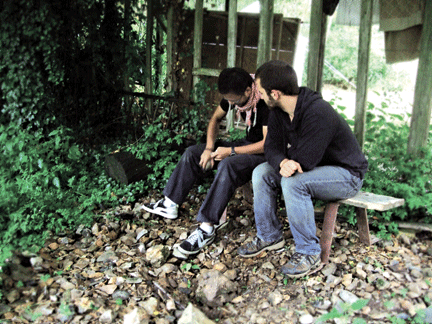
Dibble has also weighed in on another controversy in Paleolithic archaeology in which the respective camps are represented by Bordes and the American archaeologist Lewis Binford. Known as the Bordes-Binford debate, it is all about how to read stone-tool variability and what stone tools are telling us about who made them, how they were made, and why they were made the way they were. Bordes argued that the different styles of tools found were distinct from each other and represented separate traditions made by different people. Binford countered that the same groups of people made stone assemblages and that the variation reflected different functions.
Dibble examined the stone assemblages in question and came away with a different conclusion—that they were not from different traditions but rather they were different stages of a tool being worked or retouched. One way Dibble argued his perspective was by using the life of a pencil as an analogy: A new pencil looks very different from a used one and a used one has different reuse and retouching patterns, being sharpened, its eraser wearing down, until the pencil is discarded in favor of a new one. Moreover, in flush times, a person may be likely to discard a perfectly good pencil for a new one with a fresh eraser. In more economically pinched times, on the other hand, they’ll reuse that pencil until it is a stub.
An innovative way that Dibble is getting at this issue is through a flintknapping machine he developed at Penn. “It’s a device I made to knap glass cores—I’m trying to test several things that the flintknappers say, since most of what they know is based on impressions or lore. This machine helps me control a lot of variables and get results that look exactly like what a flintknapper would do.”
Where a flintknapper uses experience and intuition, the flintknapping machine maps mathematically what angles, velocities, and distances create a stone tool. This helps establish patterns: what a flintknapper can do, what creates the shapes archaeologists find on site, and toward what is a human-made tool versus something shaped by natural forces.
Between dinner prep and finishing with the day’s on-site work, the crew shifted to a little relaxation. It was a small group this year: Sam Lin, an anthropology graduate student at Penn; Peter Stamos, a graduate student from the University of California at Davis; Kenny Johnson, who just graduated from Arizona State University; and Jonida Martini.
Lin and Johnson headed to the back yard’s flint pile and sat on the knapper’s bench. Lin deftly worked the stone striker against a flint core, perfecting the core-shaping, flake-removal Levallois technique as Johnson watched. I asked Johnson if he also practiced his flintknapping skills. He proudly stated, “No, I’m a bones man.” Lin looked up and smiled, “Yeah, and I’m a stones man.”
“In a sense, a stone tool is one of the few windows we have for early human behavior,” Lin explained. “Paleolithic archaeology is also really interesting since it allows us to address the question regarding the difference between modern humans and earlier hominids, such as Neandertals.”
Lin came to Penn from New Zealand in 2009. His undergraduate advisor at the University of Auckland was Simon Holdaway Gr’91, who also worked with Dibble. “I chose Harold to be my advisor mainly because of his work on lithic technology and Neandertal behavior,” Lin said. “I also really admire Harold’s commitment to science and scientific inquiry in terms of what we can say about the archaeological data.”
When we gathered for our dinner feast in the garden, the sun had set and a camping light cast a soft glow upon the assembled faces. Arrayed before us was what the hungry team declared normal daily fare: herb butter snails, braised chicken, creamed mushroom noodles, sautéed asparagus with cheese sauce, a garden-fresh salad with Harold’s secret dressing, and a dessert of cassis sorbet and chocolate chip ice cream. The conversation wove between archaeology, music, food, and humorous good cheer, often at the expense of one of the diners.
With the work at Roc de Marsal and Pech de l’Azé completed, this year’s dig season opened a new site in the Dordogne, La Ferrassie, also near Les Eyzies. A large part of La Ferrassie is Upper Paleolithic (indicating early moderns and blade technology) and the lower level is Middle Paleolithic (indicating Neandertals and Mousterian stone tools).
La Ferrassie was first excavated from 1896 to 1922 by French archaeologist Louis Capitan, aided at times by schoolteacher Denis Peyrony. In that time, they found seven Neandertal skeletons in the rock shelter. Then from 1968 to 1973, amateur archaeologist Henri Delporte further excavated La Ferrassie, and discovered an eighth Neandertal skeleton.
The team’s goal this summer at La Ferrassie was to uncover unexcavated parameters of the original site, to possibly find more skeletons if they existed, and to uncover stone tools. The hope to find both undisturbed bones and stones in context is driven by the hope to add new data to the complex debates about Neandertal behavior.
When this summer’s season concluded, Dibble wrote saying that the season went well. “We just opened it up to the point that we found the end of the former excavation and described the levels. Next year we’ll start digging for real.”
But he didn’t mention what joke he and Sandgathe pulled this year at the Hotel-Restaurant Delpeyrat. His colleague was more forthcoming: “Well,” revealed Sandgathe, “the joke this year is that there is no joke. We told them there was a really good one, so we hope they spend months looking for it. Cecile Bordes has agreed to keep it going by asking them if they found it when she runs into them in town.”
A regular contributor to the Gazette, Beebe Bahrami Gr’95 is currently at work on several writing projects focused on France’s southwest, including a travel memoir about life in the Périgord Noir from her base in Sarlat. Her greatest hope is to one day be described as the Peter Mayle of the Perigord.
SIDEBAR
Neandertals, Ourselves
Neandertals are a line of the genus Homo that lived in Europe and Asia from around 350,000 to 30,000 years ago. For reasons still being sought out in the archaeological record, around 30,000 years ago they disappeared. Most archaeologists suspect that their extinction was directly related to early modern humans’ new and adaptable behaviors as they expanded into Europe and Asia and competed with Neandertals.
Archaeologists’ raison d’être is to read as accurately and quantifiably as possible human behavior from the archaeological record, which in a Paleolithic archaeologist’s case is mostly stone-tool assemblages, animal and human bones, and the reconstructed picture of the ancient environment in which they were found. Additionally, they look to patterns and differences in stone-tool assemblages created and used by Neandertals and by early moderns toward discerning shared and differentiated behavioral traits.
In early May, Science published the work of a vast international team of scientists on the successful DNA sequencing of Neandertal bone samples from three individuals (“A Draft Sequence of the Neandertal Genome,” 7 May 2010). Comparing it with DNA from a representative sampling of living humans from different parts of the world, they discovered that among living human populations in Europe and Asia, 1-4 percent of the population carry DNA shared with Neandertals. “The new DNA study is no surprise,” according to Penn Paleolithic archaeologist Harold Dibble (see main story). “It is the much more logical possibility—that early modern humans and Neandertals interbred—and this study confirms it. The Middle East was the most likely place where interbreeding took place. [But] it’s still exciting because this confirms it.”
So far, what can we say we know about Neandertal behavior? “We know quite a bit,” says Shannon McPherron Gr’94, who first worked with Dibble at Penn and now continues various collaborations from the Max Plank Institute for Evolutionary Anthropology in Leipzig, Germany.
It’s clear that Neandertals were skilled hunters, for example—though it’s not known how they hunted—and that most of their dietary protein came from meat. And they were able to survive in colder climates than we have today, though how much of that ability derived from technology—“fire and clothing”—and how much from their biology is uncertain, he says.
“We know that some Neandertals at some times used fire. We know that Neandertals were skilled stone toolmakers who understood well how to manage their raw-material sources and occasionally moved stone over large distances. We know that by the end of the Neandertal time period they had a very large geographical extent that reached far into central Asia. We know that they reached adulthood more quickly than moderns,” McPherron adds.
“I suspect each of those statements would be agreed on by nearly all archaeologists. I think that Neandertals did not have symbolic behavior. In the rare instances when we find something that could be symbolic, it tends to be a unique find and not shared among sites in a region or it is something that post-dates [early] moderns’ arrival in Europe.” —B.B.



